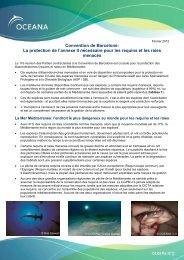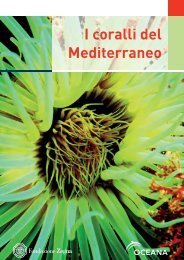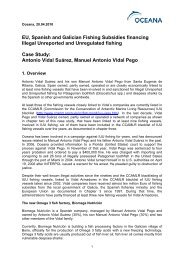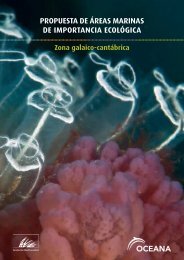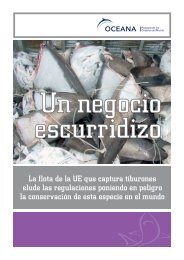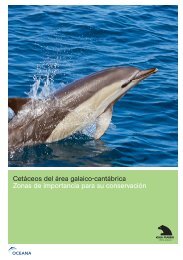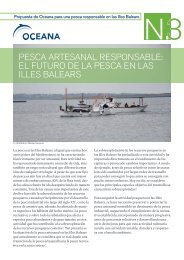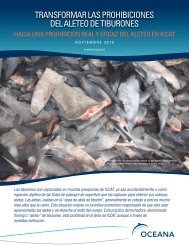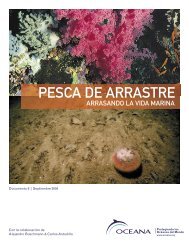Download - Oceana
Download - Oceana
Download - Oceana
You also want an ePaper? Increase the reach of your titles
YUMPU automatically turns print PDFs into web optimized ePapers that Google loves.
4.1.3. Mixed gorgonian garden (Eunicella labiata, E. gazella, E. verrucosa., Leptogorgia lusitanica,<br />
L. sarmentosa and Paramuricea clavata) on infralittoral and circalittoral bedrock<br />
DESCRIPTION: Gorgonian gardens at the infralittoral and circalittoral areas of the Gulf of Cádiz and<br />
surrounding areas usually host a huge variety of species that, depending on the specific area, can show<br />
different predominance. They can be found at only -6/-8 metres, and they continue until -80 metres on<br />
rocky bottoms with high level of sedimentation.<br />
While the eastern area is dominated by Leptogorgia lusitanica, L. sarmentosa and Eunicella gazella, the<br />
western area is covered mainly by Paramuricea clavata, Eunicella verrucosa and E. labiata.<br />
Other important species of these gardens are dead men’s fingers (Alcyonium acaule), bryozoans<br />
(Pentapora fascialis) and several hydrozoans (genus Sertularella, Gymnangium, Diphasia, etc.). This<br />
community can sometimes mix with forests of Dendrophyllia ramea and, in some areas, the scleractinian<br />
coral Dendrophyllia laboreli is also found.<br />
In shallower areas these forests coexist with communities of brown algae (Dictyota dichotoma) or red<br />
algae (Mesophyllum and Lithophyllum).<br />
Similar communities, but mainly represented by Leptogorgia spp. and Eunicella verrucosa, have been<br />
found in Atlantic areas of Galicia and the Bay of Biscay.<br />
DEPTH: 10-80 m<br />
TYPE OF SUBSTRATE: It is distributed on rocky bottoms with lots of sediment and other bottoms covered<br />
by algae, bryozoans and hydrozoans, between the infralittoral and circalittoral zones.<br />
Mixed gorgonian garden (Eunicella labiata, E. gazella, E. verrucosa, Leptogorgia lusitanica, L. sarmentosa and<br />
Paramuricea clavata) in the Gulf of Cádiz (Spain)<br />
25



